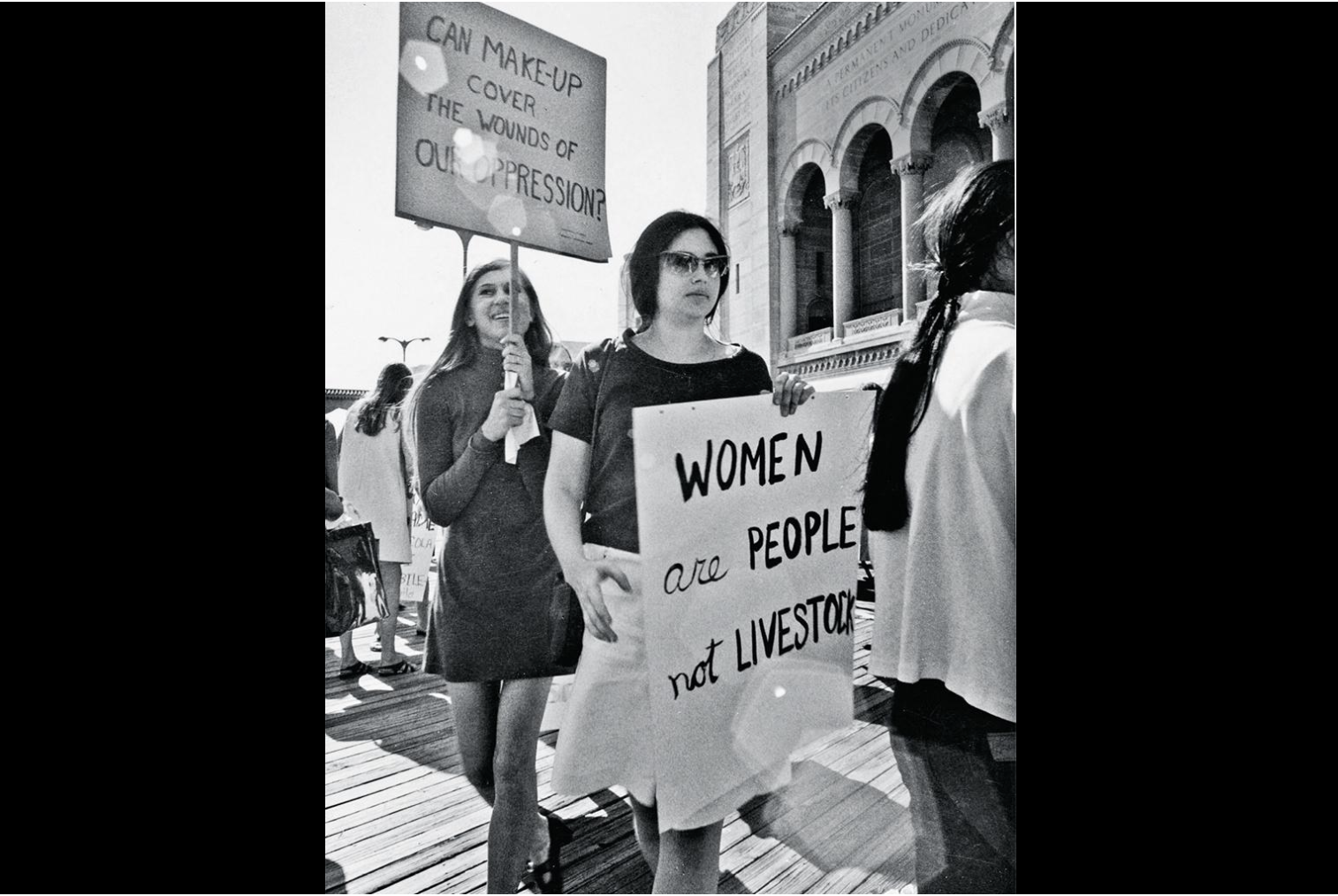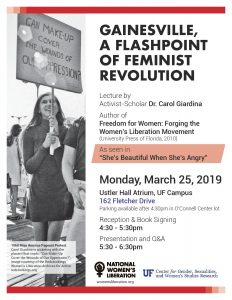
Gainesville, Florida: A Flashpoint of Feminist Revolution
Photo above: Carol Giardina, left, protests the Miss America Pageant in Atlantic City in 1968, representing Gainesville Women’s Liberation. Credit: Redstockings Archives.
Did you know that Gainesville was among the first cities to launch the Women’s Liberation Movement? The University of Florida’s Center for Gender, Sexualities, and Women’s Studies is celebrating Gainesville’s leadership from 1968 through today by welcoming activist-scholar Carol Giardina to share her experiences at the forefront of the movement.
Carol began making referrals for then-illegal abortions in 1963 from her freshman dormitory at UF. By 1968 she was representing Gainesville Women’s Liberation in the Miss America Pageant Protest, the demonstration that put the movement on the world’s radar as beauty contest protests swept small towns and world capitals. Fired from her job, blacklisted as “unemployable,” Carol was told that the protest had been entered on her “permanent record.”
She continues to organize for feminist revolution today in the “go for what we really want” spirit of the Sixties.
Carol’s talk reveals Gainesville’s hidden history in the movement’s cutting edge breakthroughs. Here she provides a sneak preview:
On a cool fall night in 1967, a heated argument erupted in Gainesville’s Quaker Meeting House. “No man respects a woman the way he respects another man!” challenged Ed Richer as he led a seminar on Simone de Beauvoir’s The Second Sex. Beverly Jones vehemently disagreed. She considered herself a respected activist leader. The debate boiled over. “I felt I’d been attacked,” said Jones. She turned to her husband Marshall but he replied, “You think that men respect you, but you’re wrong!” Beauvoir was right.
Incredulous and angry, Jones studied everything feminist she could find and began writing Toward a Female Liberation Movement with Judith Brown, also a Civil Rights and New Left leader who had supported Jones in the argument. The “Florida Paper,” as it came to be known, was the first call for an independent, all-female women’s liberation movement.
The Florida Paper made Gainesville a flashpoint of feminist revolution. When the first group in the feminist resurgence struggled for independence from the New Left in Chicago, the Paper arrived from Gainesville. Chicago group cofounder Naomi Weisstein explained: “After we got started…we were paralyzed with doubt. Was there any need for an independent women’s movement? Then the paper…transformed our thinking…we forged ahead. After that paper there would be no turning back for us or for the rest of the movement.”
“After we got started…we were paralyzed with doubt. Was there any need for an independent women’s movement? Then the paper…transformed our thinking…we forged ahead. After that paper there would be no turning back for us or for the rest of the movement.”
The Florida Paper launched at the movement’s opening conference on August 3, 1968 which Jones and Brown spearheaded organizing. A novice, I was lucky to tag along. There, we Gainesvillians met Kathie Sarachild and Carol Hanisch of New York Radical Women (NYRW).
Sarachild and Hanisch were passing out Notes from the First Year. Like The Florida Paper, Notes based its insights on women’s everyday experiences – a theory-building method of analyzing oppression the New Yorkers called “consciousness-raising.” The “New York—Florida vectors crossed,” Brown said, “and sparks have flown off and on ever since.”
Two weeks later, on August 17, we formed Gainesville Women’s Liberation (GWL), the South’s first women’s liberation organization. When NYRW led the protest of the Miss America Beauty Pageant that September, I represented GWL on the picket line.
In early 1969, Hanisch, who instigated the protest, moved to Gainesville to establish the “Freedom for Women” project with an office on 3rd avenue in the northwest student ghetto. There, Hanisch penned and circulated the paper that became “The Personal is Political,” a signature theoretical contribution to understanding all oppression. Hanisch and Sarachild would become leaders of Redstockings – an outgrowth of NYRW.
Redstockings and GWL collaboration sparked movement advances for decades to come. In 1989, GWL made front-page headlines in the New York Times as 10,000 women marched up Apalachee Parkway to Florida’s capitol carrying signs like “Gators 4 Pro Choice,” to defeat a special legislative session to ban abortion and make Florida the first state to defy Roe v. Wade. The NYT called the defeat a warning to the nation’s anti-choice governors. In 2013, using ideas from Redstockings’ archives, GWL’s ten-year “women are the experts” campaign brought the morning after pill over the counter for women and girls of all ages.
In 2018 we celebrated the 50th anniversary of the Women’s Liberation Movement. Now, let’s draw lessons: “Continuity…” Sarachild explains, “is an essential part of unity and a higher form because…To win…Women must unite and persist! But without a history, persistence is impossible… Knowing these things provides strength for a continuing radical approach and further radical action.”
Join us on March 25, 2019 – 4:30 reception, 5:30 talk. Ustler Hall, University of Florida Campus.

